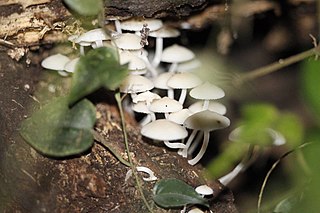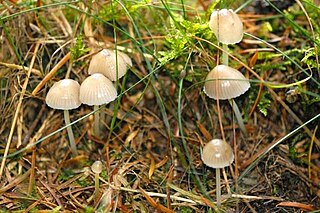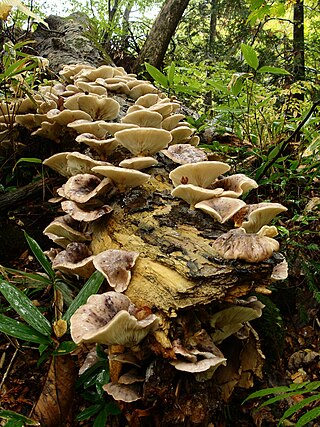
Omphalotus olearius, commonly known as the jack-o'-lantern mushroom, is a poisonous orange gilled mushroom that to an untrained eye appears similar to some chanterelles. It is notable for its bioluminescent properties. It is found in woodland areas in Europe, where it grows on decaying stumps, on buried roots or at the base of hardwood trees. It has also been reported from the Western Cape Province, South Africa. A similar, but phylogenetically distinct species found in eastern North America is Omphalotus illudens.

Omphalotus nidiformis, or ghost fungus, is a gilled basidiomycete mushroom most notable for its bioluminescent properties. It is known to be found primarily in southern Australia and Tasmania, but was reported from India in 2012 and 2018. The fan or funnel shaped fruit bodies are up to 30 cm (12 in) across, with cream-coloured caps overlain with shades of orange, brown, purple, or bluish-black. The white or cream gills run down the length of the stipe, which is up to 8 cm (3 in) long and tapers in thickness to the base. The fungus is both saprotrophic and parasitic, and its fruit bodies are generally found growing in overlapping clusters on a wide variety of dead or dying trees.

Roridomyces roridus, commonly known as the dripping bonnet or the slippery mycena, is a species of agaric fungus in the family Mycenaceae. It is whitish or dirty yellow in color, with a broad convex cap 5–15 mm (0.2–0.6 in) in diameter. The stipe is covered with a thick, slippery slime layer. This species can be bioluminescent, and is one of the several causative species of foxfire.
Gerronema viridilucens is a species of agaric fungus in the family Porotheleaceae. Found in South America, the mycelium and fruit bodies of the fungus are bioluminescent.
Mycena asterina is a species of agaric fungus in the family Mycenaceae. It is found in São Paulo state, Brazil, where it grows singly or scattered on fallen leaves in Atlantic forests. The fruit bodies of the fungus are bioluminescent.
Mycena discobasis is a species of agaric fungus in the family Mycenaceae. Found in South America and Madagascar, the fruit bodies of the fungus are bioluminescent.
Mycena fera is a species of agaric fungus in the family Mycenaceae. Found in South America, the fruit bodies of the fungus are bioluminescent.
Mycena lacrimans is a species of agaric fungus in the family Mycenaceae. Found in South America, the fruit bodies of the fungus are bioluminescent.

Mycena illuminans is a species of agaric fungus in the family Mycenaceae. It was first found on the trunk of Calamus (palm) in Jawa, Indonesia. It is bioluminescent.

Mycena tintinnabulum is a European species of agaric fungus in the family Mycenaceae. The mycelium, but not the fruit body, is bioluminescent.

Mycena zephirus is a species of agaric fungus in the family Mycenaceae. It is bioluminescent.
Mycena sublucens is a species of agaric fungus in the family Mycenaceae. Found in Indonesia, it was described as new to science in 1954 by English mycologist E. J. H. Corner. The fruit bodies are bioluminescent.
Mycena pseudostylobates is a species of agaric fungus in the family Mycenaceae. It is bioluminescent. It was originally found on the leaves of Quercus gilva in Japan.

Mycena olivaceomarginata is a species of agaric fungus in the family Mycenaceae. Originally described as Agaricus olivaceomarginata by English mycologist George Edward Massee in 1890, he transferred it to Mycena in 1893. Found in Europe and North America, the mycelium of the fungus is bioluminescent.
Mycena noctilucens is a species of agaric fungus in the family Mycenaceae. The species was first described scientifically by E.J.H. Corner in 1954. Found in Malaysia and the Pacific islands, the mycelium of the fungus is bioluminescent.
Omphalotus mangensis is a species of agaric fungus in the family Marasmiaceae. Found in China, the fruit bodies of the fungus are bioluminescent.
Poromycena hanedai is a species of agaric fungus in the family Mycenaceae. Found in Japan, the species was first described by Kobayasi in 1951. It is bioluminescent.
Roridomyces irritans is a species of fungus in the genus Roridomyces, family Mycenaceae. Originally described from New Caledonia as Mycena irritans by Egon Horak in 1978, the species was transferred to Roridomyces in 1994. The fruit bodies are bioluminescent.

Omphalotus japonicus, commonly known as the tsukiyotake(月夜茸), is an orange to brown-colored gilled mushroom native to Japan and Eastern Asia. It is a member of the cosmopolitan genus Omphalotus, the members of which have bioluminescent fruit bodies which glow in darkness. A 2004 molecular study shows it to be most closely related to a clade composed of Omphalotus nidiformis of Australia, Omphalotus olivascens of Western North America and Omphalotus olearius of Europe.







